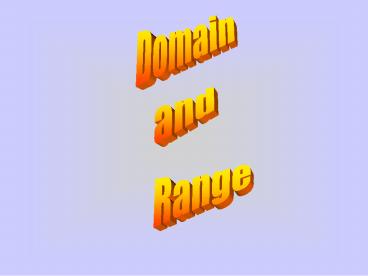Domain PowerPoint PPT Presentation
Title: Domain
1
Domain
and
Range
2
As we study functions
we learn terms like
input values
and
output values.
3
Input values are the numbers
we put into the function.
They are the x-values.
Output values are the numbers
that come out of the function.
They are the y-values.
4
Given the function,
we can choose any value we want
for x.
Suppose we choose 11.
We can put 11 into the function by
substituting for x.
5
(No Transcript)
6
If we wrote down every number we could
put in for x and still have the function
make sense,
we would have the set of numbers we call the
domain of the function.
7
The domain is the set that
contains all the input values
for a function.
8
In our function
is there any number we could
not put in for x?
No!
9
Because we could substitute
any real number
for x,
we say the domain
of the function
is the set of real numbers.
10
To use the symbols of algebra,
we could write the domain as
Does that look like a foreign language?
Lets translate
11
The curly braces
just tell us we have a set of numbers.
12
The x reminds us
that our set contains x-values.
13
The colon says,
such that
14
The symbol that looks like an e
(or a c sticking its tongue out)
says, belongs to . . .
15
And the cursive, or script,
R
is short for the set of real numbers.
16
So we read it, The set
of x
such that
x belongs to
R, the set of real numbers.
17
When we put 11 in for x,
y was 17.
18
So 17 belongs to
the range of the function,
Is there any number that
we could not get for y by
putting some number in for x?
19
No!
We say that the range of
the function is
the set of real numbers.
20
Read this
The set of y, such that
y belongs to R,
the set of real numbers.
21
It is not always true that
the domain and range
can be any real number.
Sometimes mathematicians
want to study a function over
a limited domain.
22
They might think about
the function
where x is between 3 and 3.
It could be written,
23
Sometimes the function itself
limits the domain or range.
In this function,
can x be any real number?
24
What would happen if x
were 3?
We can never divide by
0.
Then we would have to divide by
0.
25
So we would have to eliminate
3 from the domain.
The domain would be,
26
Can you think of a number
which could not belong to the range?
y could never be 0.
Why?
27
What would x have to be
for y to be 0?
There is no number we can divide 1 by to get 0,
so 0 cannot belong to the range.
The range of the function is,
28
The most common rules of algebra
that limit the domain of functions are
Rule 1 You cant divide by 0.
29
Weve already seen an example
of Rule 1 You cant divide by 0.
30
Think about Rule 2,
You cant take the square root of a
negative number.
Given the function,
what is the domain?
31
What is y when x is 16?
The square root of 16 is 4,
so y is 4 when x is 16
16 belongs to the domain,
and 4 belongs to the range.
32
But what is y when x
is 16?
What number do you square to get 16?
Did you say 4?
33
not 16.
There is no real number we can square to get a
negative number.
So no negative number can belong to the
domain of
34
The smallest number for which we can find a
square root is 0,
so the domain of
is
35
Find the domain of each function
36
Answers

